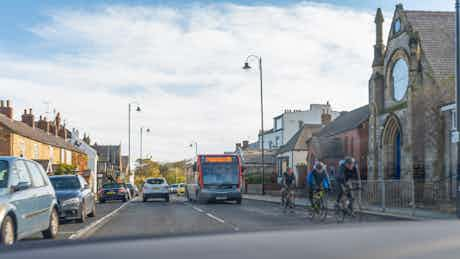Highway code changes 2022: everything you need to know
January 29, 2022 by Jamie Edkins

Car changing is a big deal
Some changes were made to the highway code at the beginning of 2022, mainly focussed around protecting vulnerable road users like cyclists. Read on for everything you need to know.
- Highway code updated as of 29 January 2022
- New Hierarchy of road users introduced
- Puts more responsibility on drivers of larger vehicles
- Pedestrians given higher priority
- New rules around charging EVs to reduce tripping hazards
What new rules were introduced?
Eight new rules were added to the highway code on 29 January 2022, with the new hierarchy of road users being the most significant change. This is split up into three rules: H1, H2 and H3.
Rule H1
The first of the new rules in the Hierarchy of Road Users puts more responsibility on the drivers of larger vehicles to look after more vulnerable road users.
The rule states that:
‘Those in charge of vehicles that can cause the greatest harm in the event of a collision bear the greatest responsibility to take care and reduce the danger they pose to others.

‘This principle applies most strongly to drivers of large goods and passenger vehicles, vans/minibuses, cars/taxis and motorcycles.”
Rule H1 also says that cyclists and horse riders have a responsibility to look after pedestrians. It also stresses that all road users have responsibility to ensure their own safety, as well as that of others.
Rule H2
Rule H2 is for drivers, motorbike riders, horse riders and cyclists. It states: ‘At a junction you should give way to pedestrians crossing or waiting to cross a road into which or from which you are turning.’

Essentially this means if you are turning into a road and there’s a pedestrian waiting to cross, you should give way to them. Cyclists also have to give way to pedestrians on shared-use cycle tracks.
Rule H3
This next update is aimed at drivers and motorcyclists, it states that ‘You should not cut across cyclists, horse riders or horse drawn vehicles going ahead when you are turning into or out of a junction or changing direction or lane.’
You shouldn’t turn at a junction if doing so would cause a cyclist or horse rider to stop or swerve. Instead, you’re advised to wait for a safe gap before turning in.
What other rules have been introduced?
Several other new rules have been introduced to further clarify when pedestrians have priority on the road. Cyclists are advised to take care when overtaking pedestrians and horses by slowing down and alerting them using their bell.

Cyclists are also now advised to ride in the centre of their lane to make themselves more visible on quiet roads and in slow moving traffic, or on the approach to junctions when it would be unsafe for a vehicle to overtake.
When riding a bicycle on faster moving or busier roads, it is advised that you leave enough space for drivers to overtake when it is safe to do so. The gov.uk website has more information on the new rules.
New rules for EV charging
In addition to the hierarchy of road users, a new rule has been introduced for drivers of electric cars to help reduce the tripping hazards posed by charging cables. Rule 239 now states:
“When using an electric vehicle charge point, you should park close to the charge point and avoid creating a trip hazard for pedestrians from trailing cables. Display a warning sign if you can. After using the charge point, you should return charging cables and connectors neatly to minimise the danger to pedestrians and avoid creating an obstacle for other road users.”
How is the highway code enforced?
The highway code is being updated to improve road safety for vulnerable road users, but there will be no changes to the law. The rules of the highway code are advisory, meaning a person won’t be prosecuted for not complying with them.
However, the highway code can be used in court to establish liability in the event of an accident under the Road Traffic Act. This includes rules which say ‘should/should not or do/do not.’
If you are found to be at fault in an accident as a result of not complying with the Highway Code, you may face charges in court.
Looking for a great deal on your next car? Head over to the carwow configurator build your ideal model and get the best offers from our trusted dealers. Not sure what you wont? Tap the button below to get help choosing your ideal car.